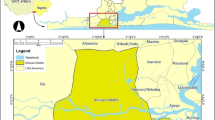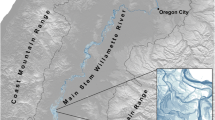Abstract
Poyang Lake is the largest freshwater lake in China. This paper conducted a digital and rapid investigation of the lake’s wetland vegetation biomass using Landsat ETM data acquired on April 16, 2000. First, utilizing the false color composite derived from the ETM data as one of the main references, the authors designed a reasonable sampling route for field measurement of the biomass, and carried it out on April 18–28, 2000. Then after both the sampling data and the ETM data were geometrically corrected to an equal-area projection of Albers, linear relationships among the sampling data and some transformed data derived from the ETM data and the ETM 4 were calculated. The results show that the sampling data is best relative to the band 4 data with a high correlation coefficient of 0.86, followed by the DVI and NDVI data with 0.83 and 0.80 respectively. Therefore, a linear regression model, which was based on the field data and band 4 data, was used to estimate the total biomass of entire Poyang Lake, and then the map of the biomass distribution was compiled.
Similar content being viewed by others
References
Chen Shupeng, Zhao Yingshi, 1990. Geo-science Analyses of Remote Sensing. Beijing: Surveying and Mapping Publishing House. (in Chinese)
Chen Yiyu, Xu Yunganet al., 1995. Hydrobiology and Resources Exploitation in Honghu Lake. Beijing: Science Press. (in Chinese)
Editorial Committee of Studies on Poyang Lake (ECSPL), 1988. Studies on Poyang Lake. Shanghai: Shanghai Science and Technology Publishing House. (in Chinese)
Guan Shaofei, 1990. Phytogeographic characteristics of aquatic flora in Poyang Lake.Scientia Limnologica Sinica, 2 (1). (in Chinese)
Guan Shaofei, Lang Qing, Zhang Ben, 1987. Biomass of macrophytes of the Poyang Lake with suggestions of its rational exploitation.Acta Hydrobiologica Sinica, 11(3). (in Chinese)
Josep Penuelas, John A Gamon, Kevin L Griffinet al., 1993. Assessing community type, plant biomass, pigment composition, and photosynthetic efficiency of aquatic vegetation from spectral reflectance.Remote Sensing of Environment, 46.
Lehmann A, Jaquet J M, Lachavanne J B, 1994. Contribution of GIS to submerged macrophyte biomass estimation and community structure modeling, Lake Geneve, Switzerland.Aquatic Botany, 47.
Li Rendpng, Liu Jiyuan, 2001. An estimation of wetland vegetation biomass in the Poyang Lake using Landsat ETM data.Acta Geographica Sinica, 56 (5): 532–540. (in Chinese)
Liu Jiyuan, 1996. Macro-scale Survey and Dynamic Study of Natural Resources and Environment of China by Remote Sensing. Beijing: China Science and Technology Press. (in Chinese)
Tong Qingxiet al., 1990. Spectra and Analysis of Typical Earth Objects of China. Beijing: Science Press. (in Chinese)
Zhang Ben, 1988. The natural resources and the specific features of Poyang Lake.Journal of Natural Resources, 4 (4). (in Chinese)
Zheng Wei, Chen Shupeng, 1995. An Introduction to Remote Sensing. Beijing: China Science and Technology Press. (in Chinese)
Author information
Authors and Affiliations
Rights and permissions
About this article
Cite this article
Ren-dong, L., Ji-yuan, L. Wetland vegetation biomass estimation and mapping from Landsat ETM data: a case study of poyang lake. J. Geogr. Sci. 12, 35–41 (2002). https://doi.org/10.1007/BF02837425
Received:
Accepted:
Issue Date:
DOI: https://doi.org/10.1007/BF02837425




